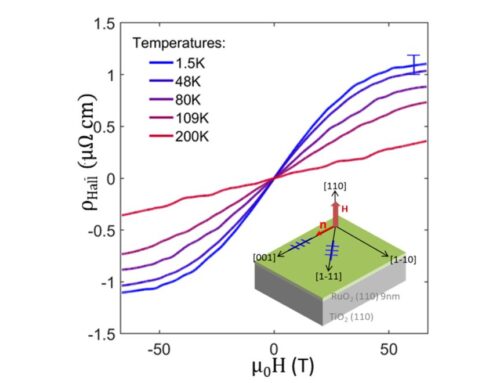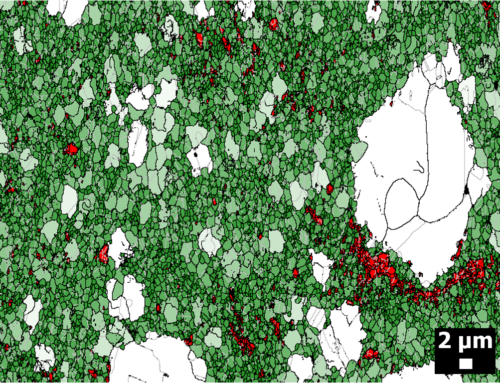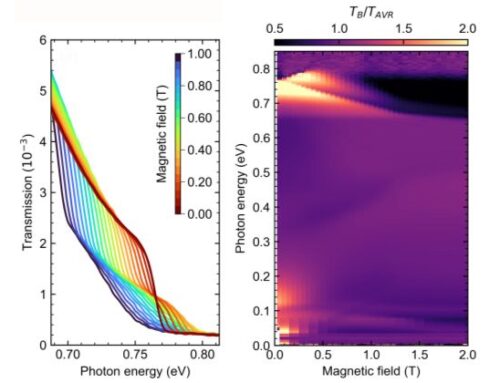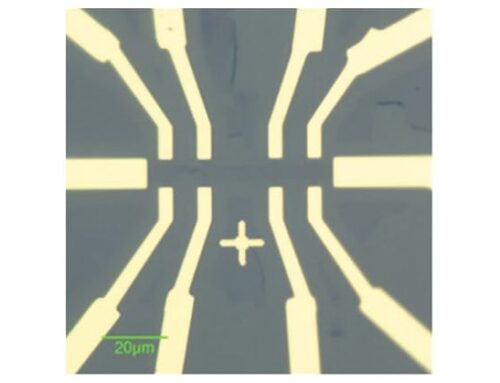P. Chudzinski, M. Berben, Queen’s University Belfast, UK, and N. E. Hussey, HFML-FELIX.
A team of researchers from HFML-FELIX, UK, USA, and China have discovered a rare phenomenon known as “emergent symmetry” in Li0,9Mo6O17(LMO). At room temperature, LMO is a 1D metal (Tomonaga-Luttinger liquid or TLL). As it cools down, however, the conduction electrons experience an emergent interaction that drives the system towards the insulating state. But rather than breaking a specific symmetry and transforming fully into an insulator, the electrons exploit the random nature of this interaction to evade localization and gradually approach the boundary (separatrix) between the insulating and superconducting states as temperature is lowered. At the boundary itself, the probability of the system being an insulator or superconductor are identical – this uniform state is then in effect a state of higher symmetry.
The electrical resistivity of LMO is extremely anisotropic, with a mysterious upturn below 30 K. Despite this, the longitudinal magnetoresistance (MR) is found to exhibit perfectly linear-in-temperature and isotropic behavior, along all measured directions, down to the lowest temperatures studied (≈ 2 K). According to TLL theory, it is the variation of the MR with temperature, as well as its independence on the orientation of the electrical current and magnetic field, which reveals the phenomenon of emergent symmetry (see Figure).
High-symmetry states have been long sought in quantum materials, for instance in the copper-oxide high-temperature superconductors, where they offer the prospect of a common parent state for superconducting, magnetic, and charge density wave instabilities. On general grounds, these high-symmetry states are interesting because, contrary to low-symmetry states, they are able to support a vast plethora of possible lowest-energy instabilities that may result in the exciting realization of exotic order, coexisting orders, or inhomogeneous order parameters. The notion that disorder or randomness on the interaction level can drive a system toward the boundary between metallicity and localization sheds light on this complex behavior. Notably, the notion itself is not specific to 1D systems such as LMO.

Figure: (A) Parametric plot of g3 – the Umklapp scattering amplitude vs. Kρ– Kρ* – the distance to the critical point for a TLL represented as a renormalization-group (RG) flow. With lowering energy, the system moves away from the separatrix (green dashed line) and toward either a gapless, metallic state or a gapped (Mott) insulating state (black dashed lines). According to theory, the emergence of a random component in g3 can steer the system (orange solid line) back toward to the separatrix. (B) Connection between the MR, as expressed through the derivative dlog(g3)/dH and RG flow. (Inset) Parametric plot of g3(l) flow as it gradually approaches the separatrix — the lower the line at Kρ– Kρ*≈ 0.1, the further away the system is initially from the separatrix [green dashed line in (A)]. (Main panel) Resultant T dependence of [dlog(g3)/dH]-1/2∝(ρ(0)/Δρ)1/2 to be compared with experiment. (C) In-chain resistivity ρb (T), showing the deviation from linearity below 110 K (red arrow), the tendency towards an insulating state below 30 K, and superconductivity at ≈ 2 K. (D) Despite these changes in ρb(T), (ρ(0)/Δρ)1/2 exhibits perfect linearity at all temperatures from 300 K down to 3 K (see inset).
Emergent symmetry in a low-dimensional superconductor on the edge of Mottness, P. Chudzinski, M. Berben, X. Xu, N. Wakeham, B. Bernáth, C. Duffy, R. D. H. Hinlopen, Y.- T. Hsu, S. Wiedmann, P. Tinnemans, R. Jin, M. Greenblatt, and N. E. Hussey, Science 382, 792 (2023).
https://www.science.org/doi/10.1126/science.abp8948
Contact: nigel.hussey@ru.nl, n.e.hussey@bristol.ac.uk





